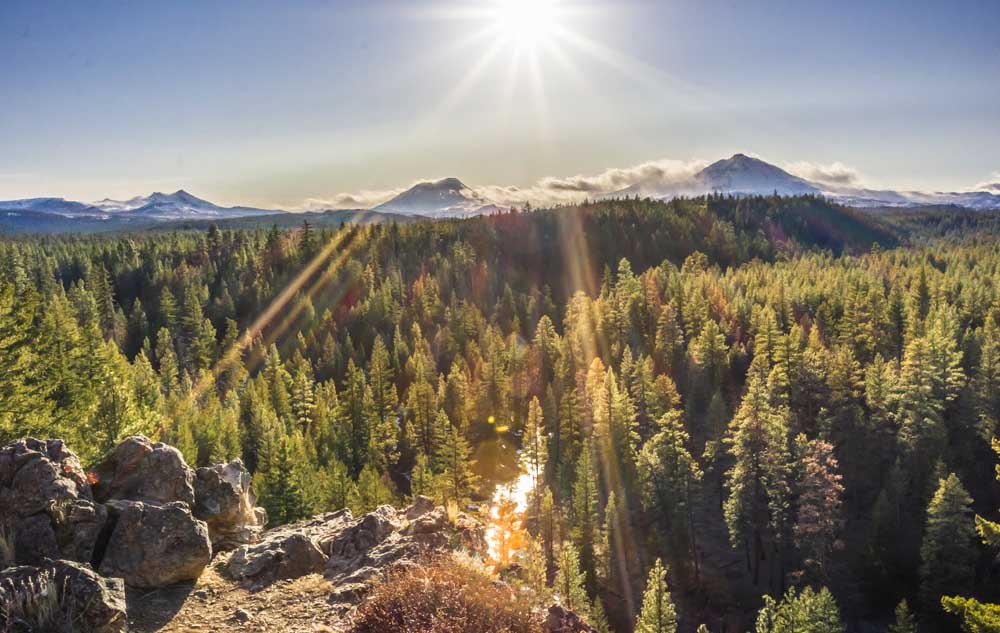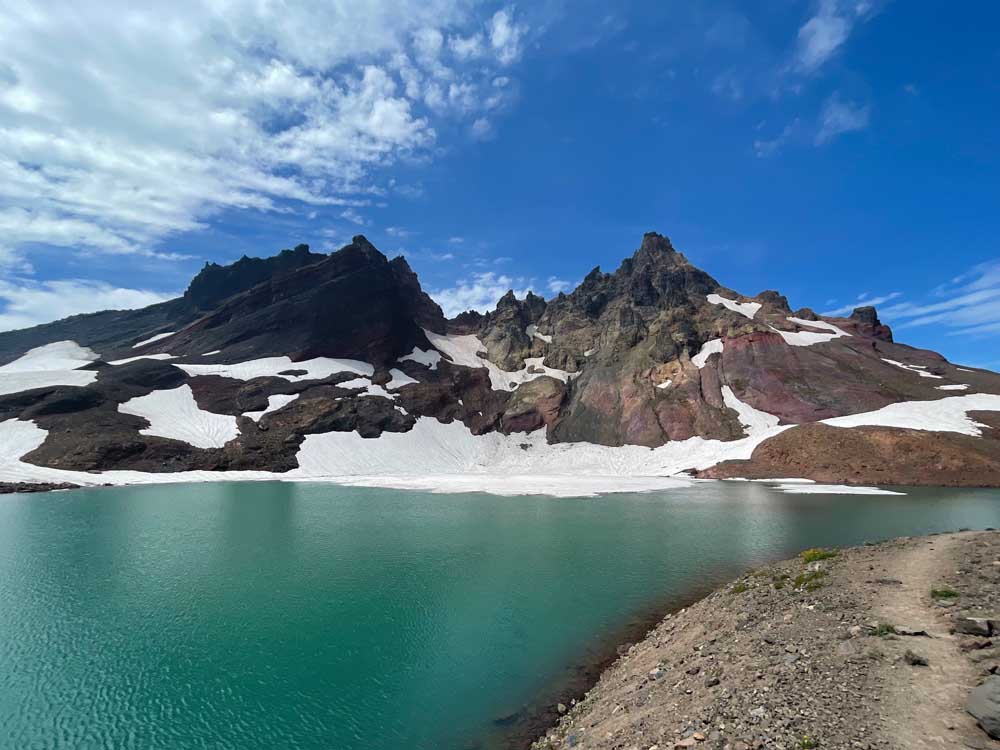Day Tripper: Sisters and Camp Sherman are picture perfect any time of year
Published 12:00 am Sunday, February 23, 2020

- The Three Sisters and Broken Top as seen from the Whychus Creek Overlook.
Sisters and its neighboring Camp Sherman are popular destinations when the sun is out, although they never lack adventures of all shapes and sizes when winter rolls in.
During a recent visit, cold mist dripped from hikers’ faces as they made their way to the overlook at the Whychus Canyon near Sisters where clouds swirled over the Cascades, leaving them blanketed in gray. While the weather dampened their jackets, it never dampened their spirits as they made their way down to the cool, clear waters of the Whychus Creek.
Trending
Storming Sisters (20 miles northwest of Bend) — known for the annual Sisters Rodeo, Quilt Show, Folk Festival and everything in between — and Camp Sherman (37 miles from Bend) during the off -season means far less of a crowd to fight through for some of the area’s best trails, shopping, food, drinks and more.
Water is life
Both Sisters and Camp Sherman house two of the clearest, most picturesque wild streams in the state, Whychus Creek and the Metolius River.
The Metolius is famous for its fishing opportunities. The consistent cold temperatures are perfect for fly fishing: year-round below Allingham Bridge and throughout the river during fishing season.
The river winds its way through old -growth ponderosa pine forest, cutting through canyons and exposing some waterfalls along the way.
Remarkably, the 29-mile river that empties into Lake Billy Chinook to the northeast springs nearly fully formed out of the ground near Camp Sherman.
Trending
The crystal -clear headwaters swirl in a small pool surrounded by green, algae-covered rocks before gushing forward along its route. A short, accessible paved path leads to a small observation area with benches to rest and watch the water flow.
Along the course of the river is Wizard Falls Fish Hatchery. Opened in 1947, the large hatchery hosts the large cabinlike buildings that seem to disappear within the stands of trees that surround them.
The hatchery feels more like a park than many other hatcheries around the state, with a display pond and several interpretive signs informing visitors of the history and process the hatchery goes through while spawning rainbow trout, kokanee, spring chinook and summer steelhead.
In Sisters, the Whychus Creek flows gently through town and under U.S. Highway 20. A short drive west toward the Cascades along Three Creeks Lake Road leads to several hiking and biking trails in the Deschutes National Forest lands, including the highly trafficked Tam McArthur Rim trail, which is one of a handful of hikes that will require limited day-use permits to access starting May 22 through Sept. 25.
But there are several others that will only require the self-service free permit at the trailheads, including the Whychus Creek trail, which can be accessed from a few trail heads including the Whychus Creek Overlook.
The Overlook is a 1-mile easy loop that showcases the scenic Deschutes National Forest, Black Butte to the north, the Three Sisters and Broken Top to the west and a glimpse of the creek running below.
Here you can walk beside the water by taking the Cougar Draw Trail down to the main Whychus Creek Trail where hikers can follow the river to waterfalls and through ponderosa pine and Douglas fir forests.
The Whychus is made from several mountain glacier streams that pour down the eastern flanks of the Three Sisters and empty into the main creek bed from the base of the Bend Glacier on Broken Top. As it makes its way down to the town of Sisters, it falls several times, creating some spectacular backcountry waterfalls — including Chush Falls. Access to the upper part of the creek is at higher elevations and can vary based on snow conditions.
Something old, something new
The Whychus has been a hub of activity for centuries. Chinookan, Sahaptin, Northern Paiute and Molala peoples all used the creek and the a 151-acre meadow along its banks to gather a variety of plants, hunt the deer and catch fish from the cool waters.
European Americans began exploring the area as early as 1816 and, by the 1860s, settlers began arriving in the area.
In September of 1865, a group of 40 volunteer infantrymen built what they called Camp Polk in that 151-acre meadow in an effort to quell Native American resistance in the area and protect travelers along the new Santiam Wagon Road.
However, the risk from attack or resistance was low in the area, so the camp was abandoned in May the following year.
Four years later, settler Samuel Hindman bought the old camp site and created a post office, keeping Camp Polk for the name.
In 1888 the post office was moved and the name changed to Sisters after the Three Sisters mountains, officially establishing the town in 1901.
Sisters experienced growth through the 1930s and ’40s thanks to the timber industry, but when lumber production began to fall, the town began to turn its economic sights to tourism.
As a draw for tourists traveling through from the Willamette Valley via Santiam Pass, the city decided to enact a town ordinance in the early 1970s that all buildings in the commercial sector of town be adorned in an 1880s -style facade, creating Sisters’ iconic Old West feel.
Further north on Highway 20, Camp Sherman sits comfortably within the forest.
The unincorporated community was established mostly as a summer recreation site by Sherman County families at the turn of the 19th century (hence the name) and has since become a year-round home for 233 residents, according to the 2010 census.
During the Great Depression, the Civilian Conservation Corps set up camp here for nine years starting in 1933, naming their site Camp Sisters.
Here, young men built trails, roads and structures, including the Camp Sherman Campground picnic shelter, which remains today.
Shop ’til you drop
On and off the main drag, Sisters is home to several eateries and shopping opportunities, including antiques shops, home goods, art galleries and book stores.
While Cascade Avenue, the main street through town, boasts the highest concentration of shopping, it’s worth venturing just one block north or south for some gems.
One of these is Sisters Coffee Company on the corner of Hood Avenue and Oak Street, housed in their newer home that looks like a massive log cabin inside with a large coffee bar with knowledgeable baristas pulling espresso shots behind it.
The company, founded in 1989, is one of the oldest coffee roasters in Central Oregon and today, according to its website, roasts over 300,000 pounds of beans every year.
If a different type of brew is more your style, Three Creeks Brewing Company offers a wide selection of rotating special drafts as well as four year-round beers in their welcoming pub off Highway 20.
One great thing about shopping (or window shopping) in Sisters is that everything is within walking distance.
Hood Avenue has the largest concentration of art galleries, featuring a variety of pieces to view from local and regional artists. In fact, all but one gallery resides on or just off this street. The outlier is Canyon Creek Pottery on the corner of Adams and Cedar Street and is worth the extra steps to get there.
While Camp Sherman has a couple restaurants, now including Hola (its sixth location in Central Oregon) and the Lake Creek Lodge, there is really only one shop you will need — and it just happens to be the oldest.
The Camp Sherman Store was built in 1917, rebuilt in 1922 and has remained open ever since. Operating as both a fly shop and general store, you can find pretty much anything you need including a few stories or tips from the friendly shopkeepers.
Anytime is good
There’s a reason people have been making the trip to the Sisters and Camp Sherman area for generations. Because of the activities that are offered for hikers and fisherman as well as art aficionados and foodies, these two communities have what others may not — a spectacular view.
It’s not just the mountains either. It’s the streams that spring out of the ground and trickle down from the highest peaks, the towering tree -lined roads and trails, the quaint cabins and quintessential Old West facades.
These towns have created picture -perfect memories throughout the generations that will no doubt continue to charm for years to come.








